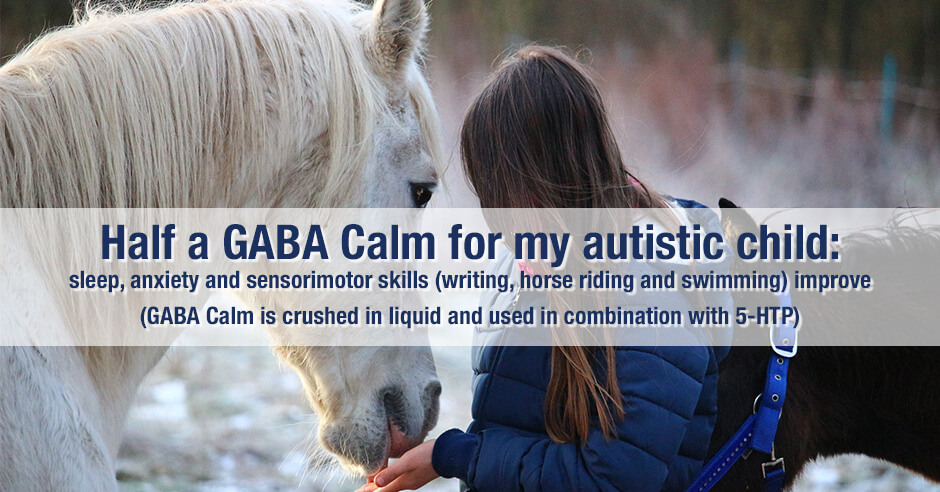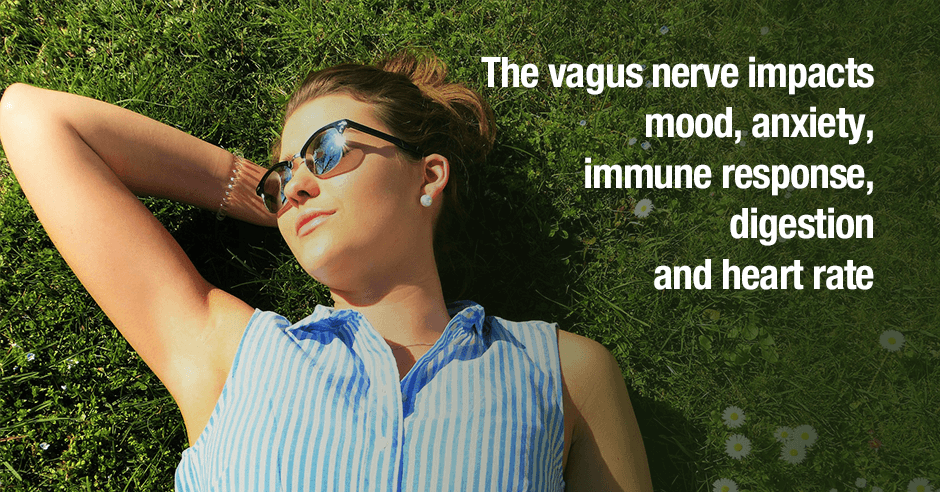
The inhibitory neurotransmitter GABA (gamma-aminobutyric acid) and the main excitatory neurotransmitter glutamate released by neurons in the cerebellum play an important role in sensory processing in autism. Research shows GABA to be low and glutamate to be elevated in autism spectrum disorders. While we don’t have any research supporting the amino acid GABA (used as a supplement) to raise GABA levels (and counter high glutamate levels) in autism, we do have much clinical evidence i.e. GABA can have a major impact on sensorimotor skills, as well as improving sleep, anxiety and social interaction. Today I’m sharing feedback from a mom whose autistic child is experiencing these benefits. Here is Vic’s feedback in her own words:
I use half a GABA tablet crushed in liquid for my autistic child (the Source Naturals you recommend) and it definitely helps. A whole GABA tablet and we see increased waking in the night but half seems perfect.
I’m using GABA in combination with 5-HTP. GABA was added after 5-HTP because it didn’t feel enough on its own and sleep and anxiety definitely improved at that point. We tried L–tryptophan first without success.
Sleep and sensorimotor skills have improved since weaning off an SSRI and onto the above combination as her willingness to engage with social interaction. We are also working on OT (occupational therapy) and retained reflexes and so improvements may be from that too.
Oh also supplementing b6, but not zinc as she refused it due to taste (which from reading means she probably doesn’t need it)
On a personal note there’s no way I’d manage to get her to drink [GABA Oolong] tea with her taste sensitivities – same reason I’m crushing rather than sublingual so practically speaking Source Naturals GABA is much easier than copying what they did in the study.
Vic is referring to the GABA Oolong tea study – GABA Oolong tea in children with autism: improvements in sensorimotor skills, autism profiles, anxiety and sleep (new research).
This very small (nine children) recent study found “significant improvement in manual dexterity and some large individual improvements in balance, sensory responsivity, DSM-5 criteria and cortisol levels with GABA tea.” They ingested the equivalent of 39.2 mg GABA for the day.
Sensorimotor skills that have improved: pen and pencil use, horse riding and swimming
I was thrilled to see her wonderful feedback in the comments section of the above blog and shared my delight, asking her which sensorimotor skills have improved. Vic shared this:
Sensorimotor wise, the biggest improvement I’ve noticed is her pen and pencil use – she’s actually being able to write and draw what she wants better than she was and she’s less avoidant of it in general. Her hand/eye referencing is noticeably better and her pressure control with a writing implement.
Her balance and core strength is improving (OT feel core strength generally doesn’t come properly until those internal senses are functioning) – her horse riding instructor commented on the change in how she is able to hold herself on a horse – especially when the horse got an unexpected itch the other week and she could simply adjust her body without conscious effort. Before she would have wobbled if a horse had done that.
She’s now teaching herself to swim as she has a better sense of body awareness to coordinate her limbs to all be doing what she wants.
So yeah mostly vestibular, proprioception and interoception are all working better!
As you’ll read below, research does show that GABA plays a role in sensorimotor difficulties in autism.
Some of my feedback on the GABA product and dosing, and adding it after 5-HTP
In case you’re not familiar with the Source Naturals GABA Calm product, it’s a sublingual tablet that contains 125 mg GABA (and some other ingredients). It’s typically used as a sublingual i.e. held in the mouth and dissolved, but this mom has figured out that crushing it and mixing it in liquid works best for her daughter.
To see these results with only 62 mg GABA is impressive. But as I’ve shared before, dosage does depend on your unique needs and there can be a large variation in dosing. As mentioned above, in the GABA Oolong autism study, the equivalent of 39.2 mg GABA was used daily.
That said, I did say I’d consider exploring a GABA only product at night if there are still some low GABA symptoms that remain. This could also be mixed in water.
Given that her daughter is doing occupational therapy too and also using 5-HTP and vitamin B6 (since low serotonin and pyroluria/social anxiety is common in autism) it can be challenging to tease out how much has improved with GABA alone. Vic did add GABA after having started 5-HTP and this is the best way to know what is helping which symptoms i.e. using a layered approach.
It’s also good that she figured out 5-HTP was beneficial when tryptophan wasn’t. It’s not unusual that some folks do better on one vs the other.
GABA does play a role sensorimotor difficulties in autism – the research
As reported in this 2016 paper, The Role of Sensorimotor Difficulties in Autism Spectrum Conditions:
In addition to difficulties in social communication, current diagnostic criteria for autism spectrum conditions also incorporate sensorimotor difficulties, repetitive motor movements, and atypical reactivity to sensory input.
GABA does play a role in sensorimotor difficulties as reported in this same paper. Here are some of the highlights:
- The inhibitory neurotransmitter GABA (gamma-aminobutyric acid) and the main excitatory neurotransmitter glutamate released by [neurons in the cerebellum] play an important role in sensory discrimination in autism. GABA is known to decrease the firing of neurons , thereby reducing and inhibiting sensory feedback.
- GABAergic functioning has been implicated in tactile reactivity.
- Reductions in GABAergic system have been discovered in brain tissue: with significant reductions in GABAA receptors, 63% reduction in comparison to controls, and a reduction by 61% of the glutamic acid decarboxylase protein (the enzyme responsible for converting glutamate into GABA).
- Increased glutamate levels (excitatory neurotransmitter) in blood and platelets have been found in autism subjects, suggesting impaired conversion of glutamate to GABA, consequently increasing the excitatory state of the brain.
In the section on future directions, the authors conclude that addressing the deficiency of the inhibitory neurotransmitter GABA in the cerebellum of those with autism, “could have a global impact on sensorimotor planning, cognitive and social development.” They recommend a non-evasive GABA substitute such as oolong tea.
Elsewhere in the paper, they mention the amino acid l-theanine which “blocks the binding of l-glutamic acid to glutamate receptors in the brain, thereby perhaps aiding the improvement in motor activity by increasing inhibition of movement.”
I’d like to propose that the amino acid GABA is the subject of future research, given what we see clinically.
Resources if you are new to using amino acids as supplements
If you are new to using GABA or any of the other amino acids as supplements, here is the Amino Acids Mood Questionnaire from The Antianxiety Food Solution (you can see all the symptoms of neurotransmitter imbalances, including low GABA and low serotonin).
If you suspect low levels of any of the neurotransmitters and do not yet have my book, The Antianxiety Food Solution – How the Foods You Eat Can Help You Calm Your Anxious Mind, Improve Your Mood, and End Cravings, I highly recommend getting it and reading it before jumping in and using amino acids on your own so you are knowledgeable. And be sure to share it with the practitioner/health team you or your loved one is working with.
There is an entire chapter on the amino acids and they are discussed throughout the book in the sections on gut health, gluten, blood sugar control, sugar cravings, self-medicating with alcohol and more.
The book doesn’t include product names (per the publisher’s request) so this blog, The Antianxiety Food Solution Amino Acid and Pyroluria Supplements, lists the amino acids that I use with my individual clients and those in my group programs. You can find them all in my online store.
If, after reading this blog and my book, you don’t feel comfortable figuring things out on your own (i.e. doing the symptoms questionnaire and respective amino acids trials), a good place to get help is the GABA QuickStart Program (if you have low GABA symptoms). This is a paid online/virtual group program where you get my guidance and community support.
If you are a practitioner, join us in The Balancing Neurotransmitters: the Fundamentals program. This is also a paid online/virtual program with an opportunity to interact with me and other practitioners who are also using the amino acids.
I’m so happy for this young girl and she and her family must be thrilled with her results. I really do appreciate Vic for sharing this outcome – it’s so inspiring and also motivating if you are a parent.
Have you used the amino acid GABA personally or with clients/patients and observed improvements in sensorimotor skills? How much and what benefits have you seen? Which product have you used? Please do share if the diagnosis is autism spectrum disorder or something else.
Have you also seen improvements with anxiety, sleep and social skills when using the amino acid GABA?
Feel free to post your questions and feedback in the comments below.
